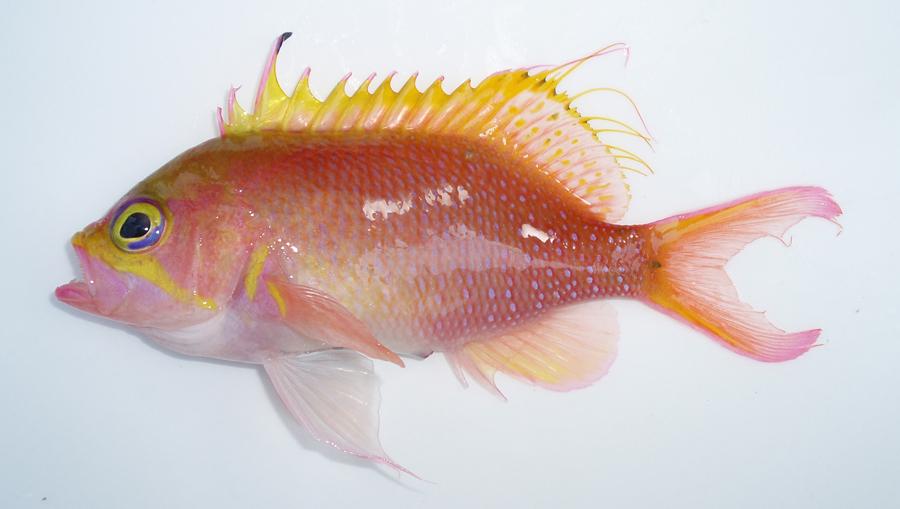Odontanthias is a small genus which includes slightly over a dozen species. Members of this genus are quite unlike the slender cliché of regular anthiines, and are characterized by having rather deep body profiles and steep foreheads. Being exclusive worshippers of deep waters, many species are poorly known and were described based on individual specimens. This lack of data and physical specimens is translated in museums as well, where very few paratypes grace the shelves of ichthyological collections. [Above photo credit: Zukan]
Five species of Odontanthias are collected for the aquarium trade, of which O. borbonius is the commonest. Its penchant for relatively shallower (albeit still deep) waters in collection prone areas like Indonesia has resulted in the “overexposure” of this species since its trade debut. The other four are found exclusively in waters exceeding 300ft (100m), and aside from the rebreather collected O. fuscipinnis in Hawaii, are exceedingly rare and very infrequently seen.

O. chrysostictus, O. unimaculatus and O. katayamai are never collected by conventional SCUBA. Because no commercial rebreather diving exists in their geographical range, the three are only brought to light via trawler or line fishing. The traumatic and often accidental hauling of these species almost always results in death, but the few that miraculously survive are offered to the aquarium trade at exorbitant prices.
The soul crushing depths in which these species occur inadvertently results in poor documentation of their naturally occurring range. Odontanthias katayamai is as far as we know, only found in Japan and adjacent Saipan with strays occurring in Taiwan. Outside of this range it is replaced by the similar O. chrysostictus, which ranges in Indonesia, although its absolute span is still unknown. O. unimaculatus was thought to exist in Japan and Taiwan, south to the Philippines. In 2011 it was documented for the first time in Indonesia, via a single specimen sold at the fish market, proving again that their propensity for deep water is nothing but a hindrance in finding out their complete geographical distribution.

The occurrence of O. unimaculatus in Indonesia makes this the fourth species to inhabit these waters, with the other three being O. borbonius, O. chrysostictus and O. rhodopeplus; the last species has never been caught alive. These deepwater anthiines are mostly fished up from North Sulawesi, although other deepwater hotspots like Bali do harbor them as well.

O. unimaculatus is strawberry pink with a constellation of highly reflective pearlescent spots on its rear end. The head is of the usual form with a variably extensive mustard mask, but usually less developed than O. chrysostictus and O. katayamai. The mask bleeds down the cheek forming an oblique sash, terminating just shy of the pectoral fin base. The dorsal fin is yellow, with the edges tipped in fuchsia. The third dorsal spine is longer, sometimes possessing a very short filament, and the soft dorsal rays are threaded rather extensively. The caudal fin is strongly lobed on each terminal, is hot pink and threaded.
O. unimaculatus is not rare in its range, and is frequently hooked up by fishermen or trawled onto commercial fishing boats. The physical trauma these fishes sustain during the rapid ascent nearly always kills them, but the odd one or two specimens that survive the barotrauma, botched needling and journey back to shore are sold to collectors at ridiculous prices. Specimens that die are either discarded, or sold as food in fish markets.

In Japan, O. katayamai is caught in the same fashion, but appears to be the commoner of the two and is more popular. The photo above shows a typical scenario of a Japanese angler’s bucket, with Odontanthias being a rather common by-catch. Other deepwater reef fish that occasionally take to baited hooks include Plectranthias, Parapercis, Genicanthus, Chaetodon and surprisingly, Cirrhilabrus (lanceolatus).
The bloated bellies and bulging eyes are characteristic signs of severe barotrauma, and in less hopeless specimens, bleeding the swim bladders with a hypodermic needle may still prove effective. A recompression chamber in this case would help tremendously, with numerous examples being carried out in California on rockfish proving to be highly curative. A rapid recompression post barotrauma “squeezes” the organs back into place with seemingly negligible ill effects, restoring even ocular capacity to full form.

Odontanthias unimaculatus is the only obtainable species I have not seen personally, but with hope one day I’ll be able to, and photograph it. It’s unlikely that this fish will ever land in Singapore, so a trip to Japan is warranted. Perhaps i’ll have better luck with this species at a fish market, then perhaps some soy sauce and wasabi would be fitting companions.




